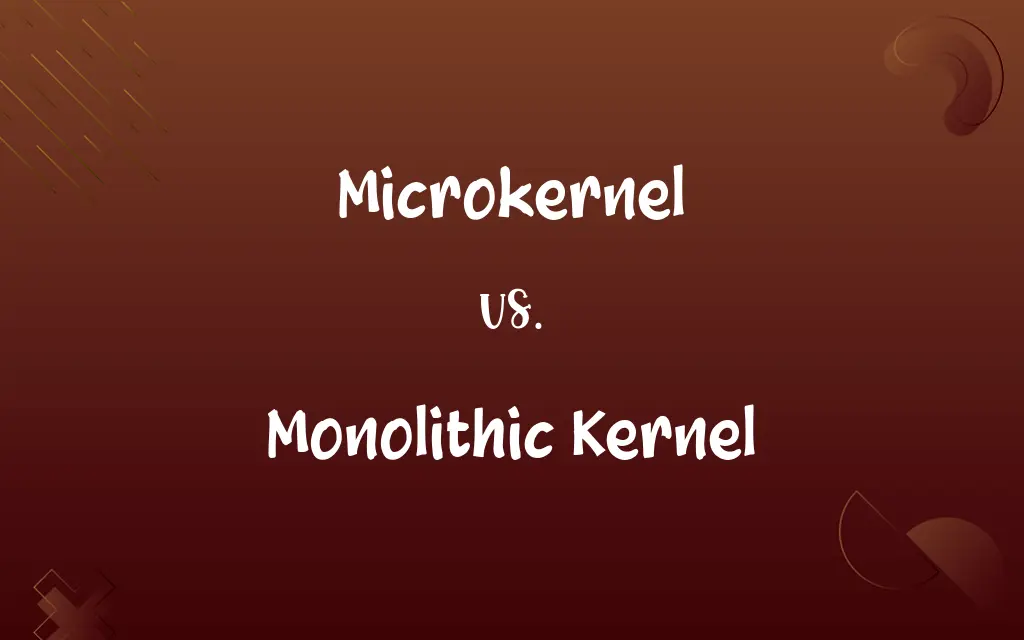Microkernel vs. Monolithic Kernel: Know the Difference

By Shumaila Saeed || Published on February 16, 2024
Microkernel is a minimalistic kernel handling only essential functions, with additional services running in user space. Monolithic Kernel is a single large kernel handling all system services and functions directly.

Key Differences
Microkernel architectures prioritize minimalism and modularity, focusing on essential core services like communication and basic I/O operations. In contrast, Monolithic Kernels incorporate not just core services but also additional functionalities like device drivers, file system management, and network stacks, all within a single kernel space. This fundamental distinction shapes their respective approaches to system design, performance, and reliability.
Shumaila Saeed
Feb 16, 2024
In a Microkernel, system components like drivers, file systems, and network protocols operate in user space, isolated from the core kernel. This separation enhances system stability and security, as failures in these components don't compromise the entire system. Monolithic Kernels, however, run these components in kernel space, allowing direct and efficient hardware and process interactions, but at the risk of system stability and security vulnerabilities due to the lack of isolation.
Shumaila Saeed
Feb 16, 2024
The Microkernel approach facilitates easier portability and scalability, as the smaller core can be adapted to different hardware with fewer modifications. Monolithic Kernels, being larger and more integrated, typically require more effort to port to new hardware platforms. This difference also impacts the adaptability of these kernels to diverse computing environments.
Shumaila Saeed
Feb 16, 2024
Maintenance and updating of a Microkernel are often simpler due to its modular structure. Individual components can be modified or replaced without affecting the entire system. In contrast, changes in a Monolithic Kernel can be more challenging, as they often require modification of the core kernel, affecting the entire system and necessitating comprehensive testing.
Shumaila Saeed
Feb 16, 2024
Performance-wise, Microkernels may experience overhead due to the inter-process communication between the kernel and user-space services. Monolithic Kernels, with their integrated architecture, often have faster performance due to direct execution within the kernel space, but this comes at the cost of increased complexity and potential for bugs.
Shumaila Saeed
Feb 16, 2024
ADVERTISEMENT
Comparison Chart
Stability
Higher, due to isolation of components
Potentially lower, due to lack of component isolation
Shumaila Saeed
Feb 16, 2024
Performance
May have overhead due to inter-process communication
Generally faster due to direct kernel execution
Shumaila Saeed
Feb 16, 2024
Maintainability
Easier, due to modularity
More complex, due to integrated nature
Shumaila Saeed
Feb 16, 2024
Adaptability
More adaptable to different platforms
Less adaptable due to size and integration
Shumaila Saeed
Feb 16, 2024
ADVERTISEMENT
Microkernel and Monolithic Kernel Definitions
Microkernel
A microkernel is a minimal kernel, handling only core functions.
The microkernel's lightweight design simplifies system updates.
Shumaila Saeed
Jan 24, 2024
Monolithic Kernel
Monolithic kernel offers high performance due to integrated architecture.
The monolithic kernel provides faster file system access.
Shumaila Saeed
Jan 24, 2024
Microkernel
Microkernel emphasizes modularity and minimalism in kernel design.
The microkernel's modular approach aids in easy porting to various platforms.
Shumaila Saeed
Jan 24, 2024
Monolithic Kernel
Monolithic kernel is less modular, combining multiple functionalities.
The monolithic kernel's non-modular design integrates network protocols.
Shumaila Saeed
Jan 24, 2024
Microkernel
A microkernel facilitates better security and stability by isolation.
System stability is enhanced in the microkernel due to isolated components.
Shumaila Saeed
Jan 24, 2024
ADVERTISEMENT
Monolithic Kernel
Monolithic kernel's complexity can pose challenges in maintenance.
Updating the monolithic kernel requires extensive system testing.
Shumaila Saeed
Jan 24, 2024
Microkernel
Microkernel architecture involves user-space management of services.
The microkernel delegates file system management to user space.
Shumaila Saeed
Jan 24, 2024
Monolithic Kernel
A monolithic kernel integrates all system services in one large kernel.
The monolithic kernel's single-layer design streamlines direct hardware access.
Shumaila Saeed
Jan 24, 2024
Microkernel
Microkernel separates basic services from system functionalities.
In a microkernel, device drivers operate outside the core kernel.
Shumaila Saeed
Jan 24, 2024
Monolithic Kernel
Monolithic kernel handles both core and auxiliary system functions.
Device drivers are included within the monolithic kernel for efficiency.
Shumaila Saeed
Jan 24, 2024
Microkernel
(operating systems) A minimal operating system kernel offering basic mechanisms rather than abstract services.
Shumaila Saeed
Jan 22, 2024
Repeatedly Asked Queries
What makes Monolithic Kernels fast?
Integrated architecture with direct kernel-level execution of services.
Shumaila Saeed
Feb 16, 2024
Are Microkernels more flexible than Monolithic Kernels?
Yes, due to their modularity and minimalistic design.
Shumaila Saeed
Feb 16, 2024
What is a Monolithic Kernel?
A large, single kernel managing all system services and functions.
Shumaila Saeed
Feb 16, 2024
How does a Microkernel improve system security?
By isolating core functions from additional services, reducing vulnerability.
Shumaila Saeed
Feb 16, 2024
How do Monolithic Kernels handle device drivers?
They include drivers within the kernel space for efficiency.
Shumaila Saeed
Feb 16, 2024
Do Microkernels require more system resources?
They might, due to the overhead of inter-process communication.
Shumaila Saeed
Feb 16, 2024
What is a Microkernel?
A minimalistic kernel handling core functions with additional services in user space.
Shumaila Saeed
Feb 16, 2024
What type of kernel is better for real-time systems?
Microkernels, due to their modularity and fault isolation.
Shumaila Saeed
Feb 16, 2024
Can Monolithic Kernels be customized easily?
No, due to their integrated and complex structure.
Shumaila Saeed
Feb 16, 2024
Why might Monolithic Kernels be less stable?
Lack of isolation between components can lead to system-wide issues.
Shumaila Saeed
Feb 16, 2024
Can Microkernels run on various hardware platforms easily?
Yes, their minimal core is more adaptable to different hardware.
Shumaila Saeed
Feb 16, 2024
Why are Monolithic Kernels more complex to maintain?
Their integrated nature makes system-wide changes more impactful.
Shumaila Saeed
Feb 16, 2024
How does the Microkernel approach benefit system security?
By reducing the impact of a single component's failure on the entire system.
Shumaila Saeed
Feb 16, 2024
Why might developers choose a Monolithic Kernel?
For its performance benefits and direct hardware access.
Shumaila Saeed
Feb 16, 2024
Can Microkernels handle large-scale systems efficiently?
Yes, but with potential performance trade-offs.
Shumaila Saeed
Feb 16, 2024
Do Microkernels support distributed systems well?
Yes, their modular design suits distributed computing environments.
Shumaila Saeed
Feb 16, 2024
Are Monolithic Kernels more suited for desktop operating systems?
Often, due to their performance and direct hardware integration.
Shumaila Saeed
Feb 16, 2024
How do updates in Monolithic Kernels affect the system?
Updates can be challenging, affecting the entire system.
Shumaila Saeed
Feb 16, 2024
Are Microkernels less prone to crashes?
Generally, yes, due to component isolation.
Shumaila Saeed
Feb 16, 2024
What is the main drawback of a Monolithic Kernel?
Its complexity and potential for system-wide vulnerabilities.
Shumaila Saeed
Feb 16, 2024
Share this page
Link for your blog / website
HTML
Link to share via messenger
About Author
Written by
Shumaila SaeedShumaila Saeed, an expert content creator with 6 years of experience, specializes in distilling complex topics into easily digestible comparisons, shining a light on the nuances that both inform and educate readers with clarity and accuracy.









































































